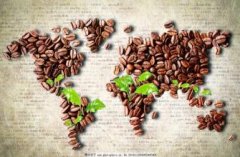Flavor description of Ethiopian Sidamo Chiso Coffee A brief introduction to the planting of the Manor production area

There are several other coffee cooperation organizations in Gima, where members share water and fertilizers, and few members are deprived of their wages under their organizations and provide health insurance for each member.
The state-owned farm has about 21000 hectares, and there are five large farms located in TEPI and BEBEKA. The area is close to Jima but most of them belong to lower areas. Each single farm occupies at least 1050 hectares of land. During the production period, the farm owner uses about 3000 long-term workers and about 3000 temporary employees, and the farm has its own washing plant. Its capacity is about 6000 pounds of raw beans per hour, and the higher quality raw beans are washed. Each kilogram can be sold by 32Birr, and the farm warehouse can store 300000 pounds.
Coffee is Ethiopia's main economic crop and the country's largest crop export and important industry. It accounts for 60% of Ethiopia's total export value and supports many small farms, as well as sugar, bananas and cotton. It is also Ethiopia's largest and important commodity export crop after oil, and it is also the largest export of Elaraby in Africa, with a total value of about US $300 million in 1997. in terms of total production, 94% are small farms and 6% are government agencies. because many farms are scattered and grow other crops, it has been difficult to integrate the figures correctly. However, the country's official coffee cultivation area is at least 400000 hectares, and the Ethiopian government encourages local farmers to improve their quality and productivity so that coffee farmers can expand their business scale and increase production capacity and exports.
During the harvest, farmers harvest fresh red fruit every day, and every two days the coffee fruit is sent as a unit or sold to a water washing plant for treatment. coffee fruit without a water treatment plant is usually naturally fermented for about 12 hours, and then passed through the sun for drying and shelling. in any case, farmers always try their best to send them to the water treatment plant for treatment. In order to sell better under the name of "washing treatment", in the water wash, coffee cherries soften the pulp after soaking and fermenting for about 12 hours, then pass through the waterway and stir to separate the pulp from the coffee beans. the pulp is discharged with the floodgates, while coffee beans need six days of sunshine to dry, but the processing time is only from sunrise to 11:00 and from 03:00 to sunset. The water content of raw beans after treatment should be about 12% ~ 12.5%. After selecting residual or shoddy beans, they are packed in sacks and trucked to the coffee auction house in the capital, Addis Ababa.
There are many water treatment plants on the main roads of coffee producing areas, especially in Jima area, and a large number of treatment plants are not fully utilized because of the fierce competition, so the person in charge of the treatment plant pays a higher price to the farmers, but worries about whether they can make a profit. Nowadays, a kilogram of raw beans usually sells for about 2 Birr (Ethiopian units). During the whole harvest period, the employees of the treatment plant worked for two months without a rest day, with a daily capacity of about ten bags per plant.
There are institutions such as research institutes in Jima, and farmers are taught to introduce new technologies and apply green manure crops to reduce fertilizer costs and improve the seeds of new varieties, so that coffee trees can have stronger resistance. the seeds are cultivated and grown for a year before they are resold to farmers, who use improved seeds and methods to plant them until the seventh year. The difference is that in the past, yields were about 600lbs per hectare, but improved yields could reach 1000 pounds per hectare, and the agency even guaranteed yields of at least 700lbs per hectare.
Important Notice :
前街咖啡 FrontStreet Coffee has moved to new addredd:
FrontStreet Coffee Address: 315,Donghua East Road,GuangZhou
Tel:020 38364473
- Prev

Description of flavor and taste characteristics of Sidamo Shakiso boutique coffee beans at 2000 meters above sea level
In the last issue, we did a blind test for coffee. This time, let's test whether the coffee from different regions can really drink the flavor it should have, such as the mellow taste of mocha wine and the fermented taste, the grass flavor of Mantenin, the stone fruit flavor of Central American beans, and the jasmine lemon peel taste of Nayega. These special flavors are what we are after when we taste coffee.
- Next

A brief introduction to the flavor and taste characteristics of Ethiopian Sidamo Chiso Coffee, which has the most unique flavor.
The biggest advantage of the area is that the soil fertility is maintained through the circulation of organic matter, using the withered leaves of the surrounding trees or the residual roots of the plants as fertilizer. Therefore, the coffee produced in cities and towns has obvious differences and characteristics. In 2010-2012, it continuously obtained the high score of CR92~94, the authoritative coffee evaluation website in the United States. Thus it can be seen that the raw beans in this area are extraordinary and rare.
Related
- Detailed explanation of Jadeite planting Land in Panamanian Jadeite Manor introduction to the grading system of Jadeite competitive bidding, Red bid, Green bid and Rose Summer
- Story of Coffee planting in Brenka region of Costa Rica Stonehenge Manor anaerobic heavy honey treatment of flavor mouth
- What's on the barrel of Blue Mountain Coffee beans?
- Can American coffee also pull flowers? How to use hot American style to pull out a good-looking pattern?
- Can you make a cold extract with coffee beans? What is the right proportion for cold-extracted coffee formula?
- Indonesian PWN Gold Mandrine Coffee Origin Features Flavor How to Chong? Mandolin coffee is American.
- A brief introduction to the flavor characteristics of Brazilian yellow bourbon coffee beans
- What is the effect of different water quality on the flavor of cold-extracted coffee? What kind of water is best for brewing coffee?
- Why do you think of Rose Summer whenever you mention Panamanian coffee?
- Introduction to the characteristics of authentic blue mountain coffee bean producing areas? What is the CIB Coffee Authority in Jamaica?

